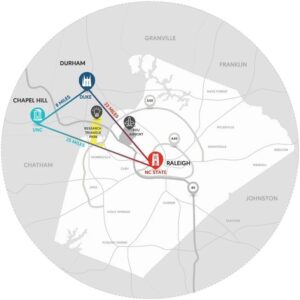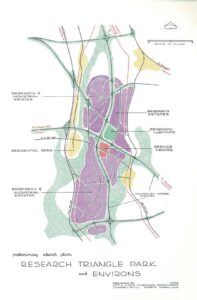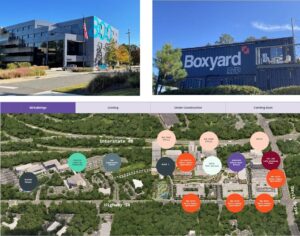(PCC) Program on Chinese Cities – Thoughts on Overseas Travels Series
Authors: Yuhang Ren,
Ph.D. candidate at the School of Public Affairs, Zhejiang University;
Joint Ph.D. student in the Department of City and Regional Planning, University of North Carolina at Chapel Hill. danielren93@163.com
The Research Triangle Park (RTP) in North Carolina, USA, is named for its location at the center of the triangle formed by Duke University, the University of North Carolina at Chapel Hill, and North Carolina State University. The development of RTP began in the 1950s when the state government of North Carolina sought to address the decline of traditional industries and the outflow of talent by establishing the park. The goal was to embrace the trend of industrial upgrading on the East and West Coasts of the United States by developing high-tech industries, thereby attracting highly educated talents, increasing employment, boosting the state’s economy, and promoting regional transformation and development. By 2022, RTP had evolved into a modern science and innovation park spanning 7,000 acres (about 2,800 hectares) with over 60,000 employees and nearly 400 established (startup) companies. The park’s enterprises are mainly involved in high-end manufacturing, biotechnology, life sciences, agricultural technology, environmental technology, data science, cybersecurity, and financial technology. RTP’s dynamism, creativity, and superior business environment earned North Carolina the title of “Best State for Business” in the USA in both 2022 and 2023. RTP’s success is attributed to its ability to seize the opportunities of the era, continuously promoting the transformation and upgrading of its development model. This article attempts to interpret the development model of RTP from the perspective of the changing relationships among industry, population, and urban development.

1. Model Evolution
The Research Triangle Foundation of North Carolina is responsible for the operation and management of RTP. As RTP’s “steward,” the Foundation is committed to promoting collaboration among industries, universities, and the government. Established in 1959, the Foundation set out with three missions: to foster close cooperation among the surrounding universities, to promote the integration of industry and academia, and to create favorable economic prospects for the residents of the state. The Foundation has successfully developed the RTP 1.0 model and is currently constructing the 2.0 model while actively exploring and planning for the 3.0 model.
1.1 RTP 1.0: “Industry-People-City” Model
Initially, the park’s development relied almost entirely on major corporations like IBM. By the end of the 20th century, the abundance of university resources, a culture that revered technology, and lower living costs made the park increasingly attractive to R&D institutions and tech companies. The Foundation seized the opportunity for transformation in the information technology and biopharmaceutical industries, attracting well-known companies like Cisco and GlaxoSmithKline to establish operations and R&D institutions in the park. Meanwhile, the North Carolina Biotechnology Center and the North Carolina Microelectronics Center, nonprofit organizations funded by the state government, settled in the park. The projects and funding they brought successfully incubated a large number of small and medium-sized enterprises, promoting steady growth in the park and generating significant influence.
In the RTP 1.0 model, industrial introduction was the core business of the park, which only had productive functions, evident from the park’s land use planning. In its early days in the 1950s, the park and its surrounding areas exhibited low-density, sprawling development characteristics, with dispersed land use, poor road connectivity, and no significant central area for economic and social activities. Despite its size, equivalent to a third of Manhattan Island, the land was primarily used to support industrial R&D and manufacturing, with only a small portion allocated for public services and residential needs within the park. Because the population moved with the industrial layout, urban service functions could only be obtained outside the park, leading to a significant spatial separation between work and residence. People relied on private cars for commuting, driving to the park from surrounding cities during the day, and returning home in the evening. The RTP 1.0 model exhibited typical “Industry-People-City” development characteristics, including single-functionality, community isolation, long commutes, and encroachment on open spaces.

1.2 RTP 2.0: “City-People-Industry” Model
The severe fragmentation of industry, population, and urban development in the RTP 1.0 model led the Foundation to recognize the need for reform of the past half-century’s development model, pushing the park into the RTP 2.0 era to enhance its vitality and competitiveness. In 2015, the Foundation announced a $50 million investment in park redevelopment, constructing public infrastructure, parks, and other open spaces, and creating a mixed-use park center (Park Center). This project comprises the following components:
- FRONTIER RTP: A dynamic, diverse, and collaborative business community offering free office space for entrepreneurs, tech workers, freelancers, and creative groups.
- BOXYARD RTP: A retail complex featuring shipping containers, consisting of bars, coffee shops, beauty stores, yoga studios, a pet park, and a fully equipped event stage, providing spaces for gatherings, dining, communication, and relaxation for park employees and the surrounding community members.
- HUB RTP: A vibrant urban center being developed by the Foundation, covering 100 acres (about 40.5 hectares) and planned to include over 1 million square feet (about 92,900 square meters) of office and lab space, 275 hotel rooms, 50,000 square feet (about 4,645 square meters) of retail space, 16 acres (about 6.475 hectares) of green open space, 1,200 residential units, and 20 miles of hiking trails. HUB RTP aims to completely transform the stereotypical image of RTP as a “research factory.”

In the RTP 2.0 model, the scale effect of industry agglomeration has begun to attract population inflows from the Northeast US and Silicon Valley, driving North Carolina to become the third-largest state in terms of population inflow in the USA, creating broad prospects for the state’s economic growth. Meanwhile, the park’s land use has started transitioning towards a high-density, mixed-use model, attempting to connect the park with the outside world through public transportation and focusing on environmental protection in development. The Foundation has shifted its focus to building public service functions such as housing, dining, business travel, and transportation, enabling the park to provide public services and facilities. This has created a comfortable working and living environment for the talent driving industry development, striving to meet the diverse needs of the growing population, promoting greater value creation for park enterprises and industries, and exhibiting typical “City-People-Industry” development characteristics.
1.3 RTP 3.0: “People-City-Industry” Model
The specific vision for the 3.0 model is still in the planning stages and has not yet taken a clear shape. Regardless of the specifics, the essence of the RTP 3.0 model should be “People-City-Industry.” Cities thrive or decline based on population agglomeration or contraction, with people being the core element of urban prosperity and industrial development. In 1933, the International Congresses of Modern Architecture (CIAM) passed a programmatic document on urban planning theory and method, known as the “Athens Charter,” which emphasized humanism and urban functional zoning. It stated that cities should be planned in coordination with their surrounding areas, with the goal of ensuring the normal operation of work, residence, recreation, and transportation functions. In recent years, literature and case studies on attracting talent through urban spatial quality and driving urban innovation development have emerged, providing inspiration for the RTP 3.0 model concept. The focus is on addressing and serving people’s needs, enriching urban functions within the park, and forming tight connections with surrounding cities.
Apple Inc. announced in 2021 that it would establish its first R&D center on the East Coast in the Research Triangle Park, which will undoubtedly drive a large number of related industries and professionals to relocate to the park. Meanwhile, research reports predict that by 2030, the population of the Research Triangle Park and its surrounding areas will increase to 2.68 million people. How to cope with the growing population, especially in providing comfortable experiences in office, residence, recreation, and transportation for innovation and entrepreneurship talents, to make it easy for talents to “come and stay,” and how to achieve rapid and flexible conversion of land use and functions despite high-density development, will be new challenges for the Foundation. Currently, the Foundation is actively engaging with businesses and drafting new development plans. It remains to be seen whether the Research Triangle Park will upgrade to a new urban model driven by innovation, integrating production, living, and ecological spaces, and providing a new model for the development of global innovative cities. In the poetic life of North Carolina’s pastoral oasis, can the exchange and collision of ideas among people spawn the next industry trend, and can the Research Triangle Park become a pioneer in leading the next industrial revolution? Let us wait and see.

2. Lessons and Insights
After World War II, North Carolina was a state with low per capita income, relying on agriculture and traditional manufacturing industries such as tobacco, textiles, and furniture. After more than half a century of transformation and development, modern technology and creative innovation are shaping a new prosperity for North Carolina, with the evolution of the Research Triangle Park’s development model serving as a classic example. As China strives to transition from a factor-driven to an innovation-driven development model, the Research Triangle Park and its evolving model offer several lessons and insights:
- The importance of universities and research institutions to regional development in today’s growth led by innovation and creativity is undeniable, which is why many provinces in China are eager to build universities and establish research institutions.
- The development planning of industrial parks should be based on the region’s resource endowment. Influenced by historical and geographical factors, the Research Triangle Park initially took full advantage of its flat terrain, low-density development, and sprawling growth, keeping land prices at a relatively low level for a long time. Today, the park’s living costs remain low, laying the foundation for continuously attracting industries and population inflows.
- The development planning of industrial parks should seize the opportunities of the times and respect market laws. The success of the Research Triangle Park is largely due to its capture of new opportunities brought by the information technology and biopharmaceutical waves at the turn of the century, achieving precise industrial positioning. At the same time, when the Foundation learned from market feedback that its long-advocated single-park model could no longer well adapt to the communication and collaboration atmosphere needed for innovation and entrepreneurship, it timely adjusted its planning and strategy, transitioning from RTP 1.0 to RTP 2.0, and proactively explored the prospects for RTP 3.0.
- The development planning of industrial parks should focus on long-term missions and visions. Since its establishment in 1959, the Foundation has established the missions and visions of “promoting collaboration, integrating industry and academia, and benefiting the people.” Today, we can still see these three missions and visions on the Foundation’s official website, which is likely why the Foundation has resisted the temptation of land lease revenue and continuously invested in the park’s new development and construction.
